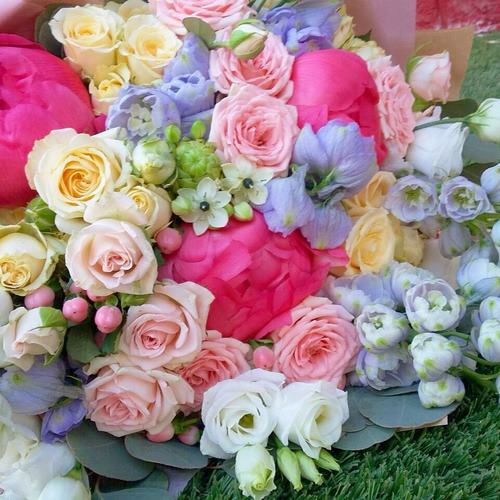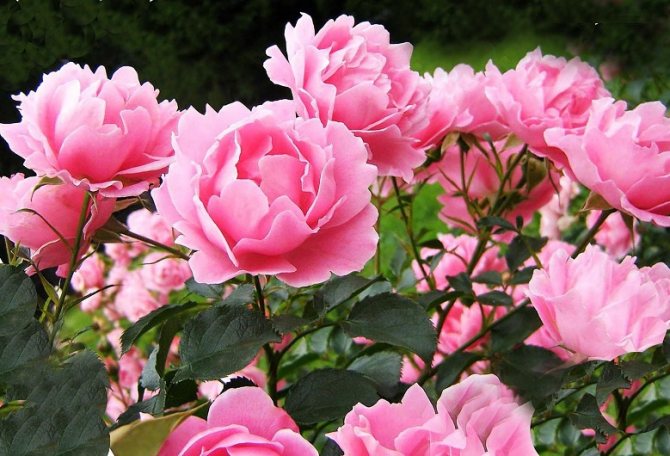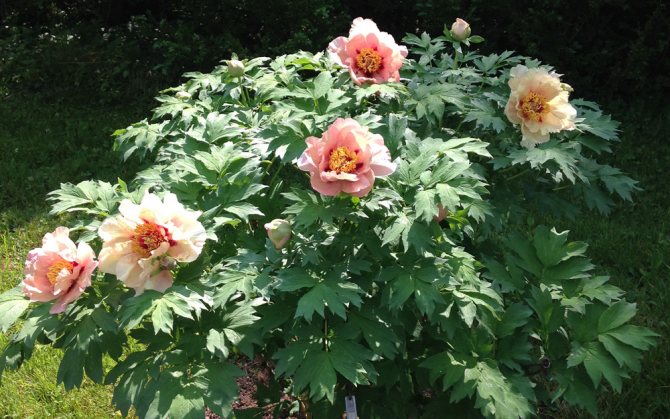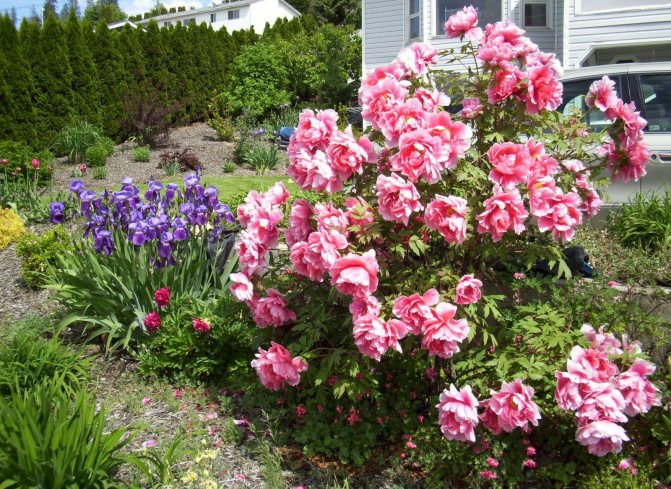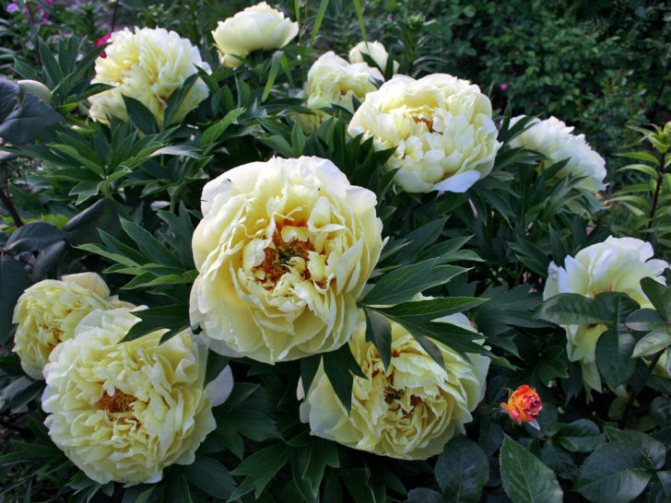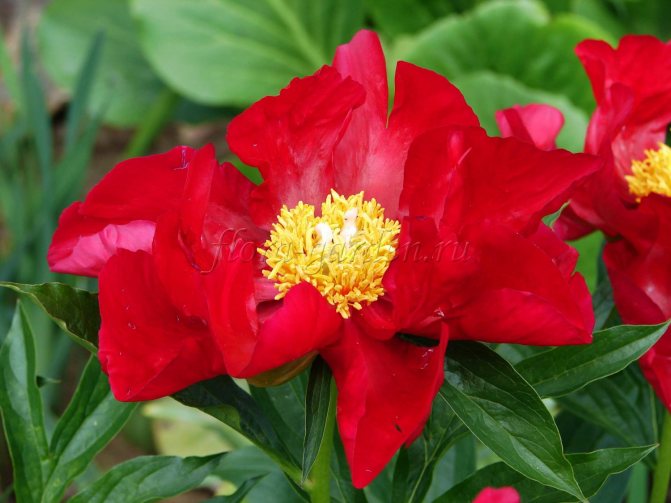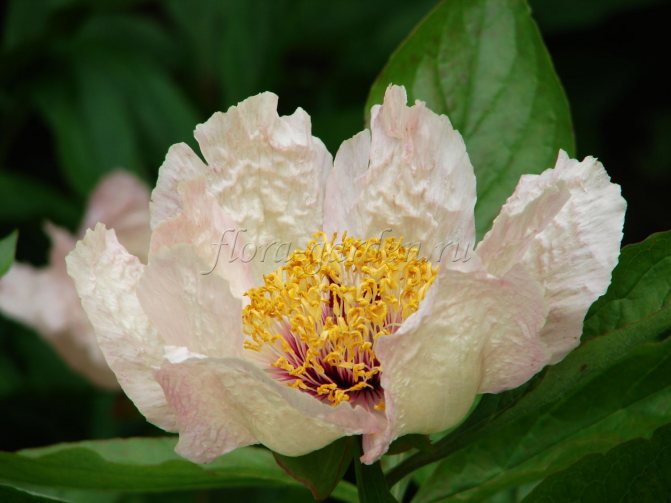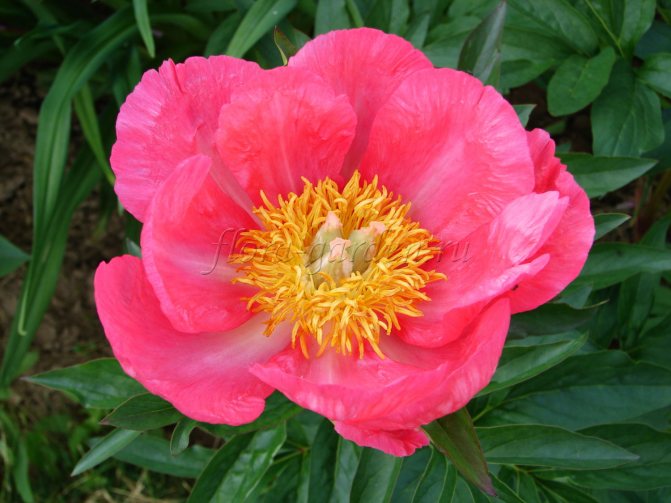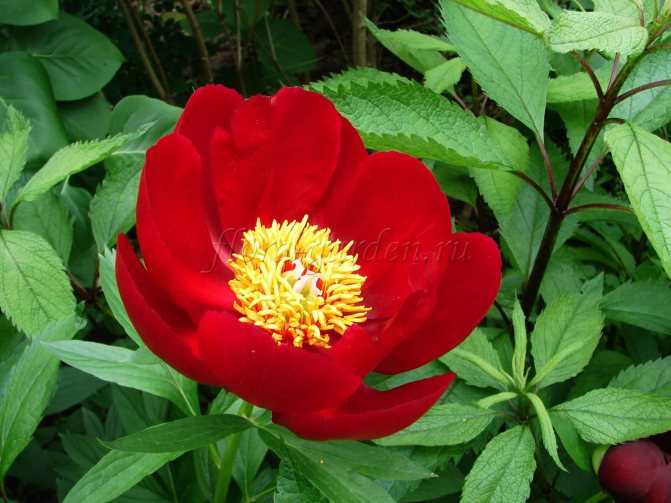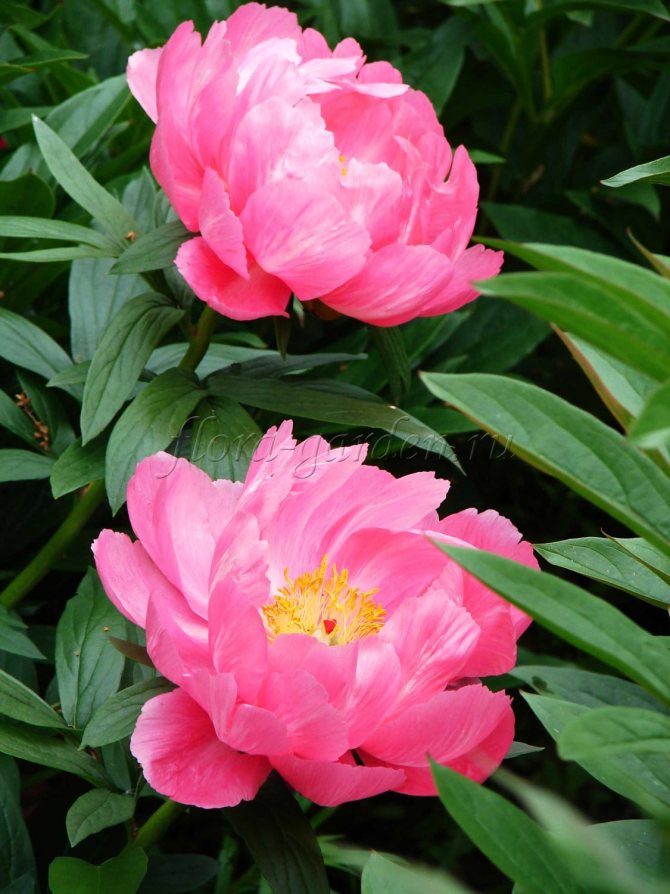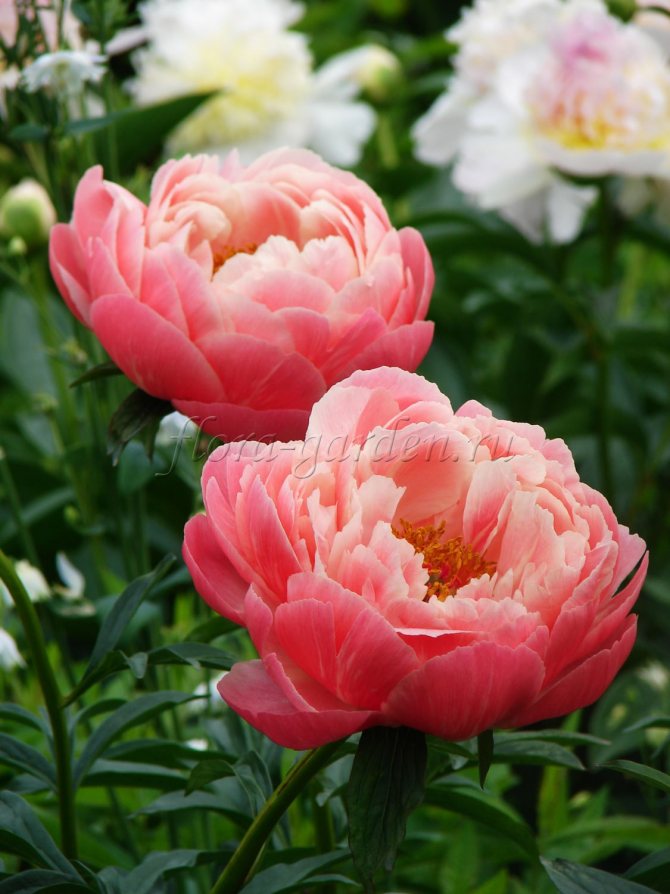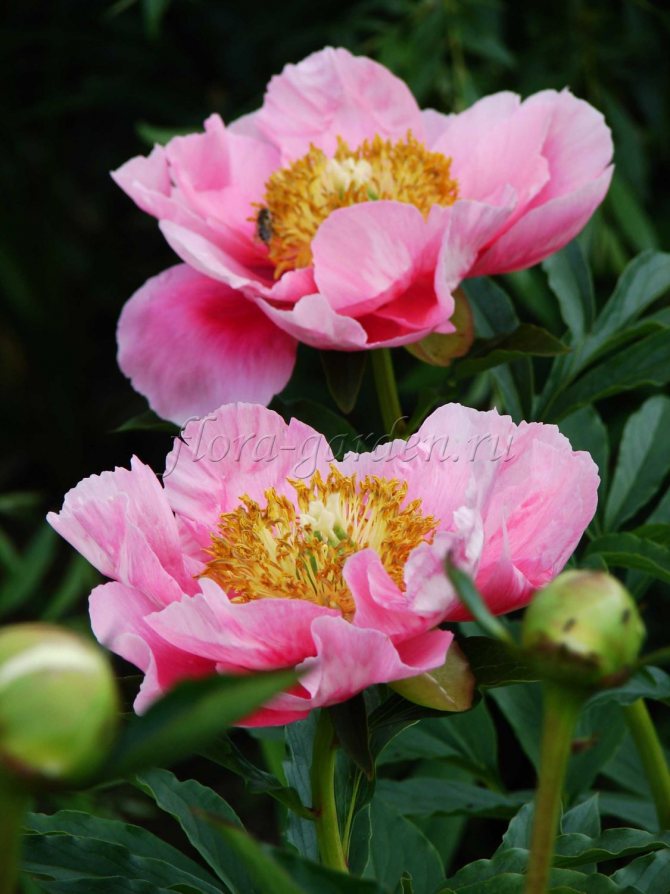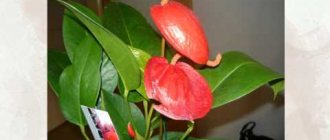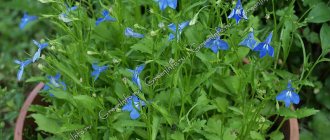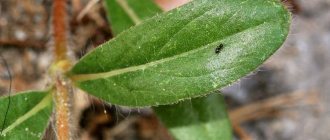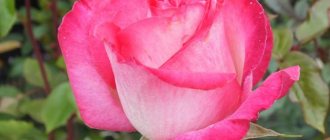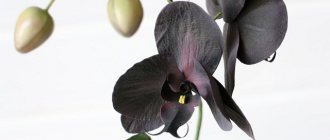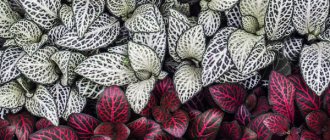What gardener doesn't dream of planting flowers with majestic and proud beauty and fragrant petals? The dream is easy to come true if you choose peonies to decorate your personal plot. They can be treelike and herbaceous, with early and late flowering, but how to choose the best option? In the article, we will consider in more detail the varieties of peonies with photos and names.
The majestic shrubs with a rich, noble aroma belong to the biological Peony family. In the Celestial Empire, it is considered a flower symbolizing love. And in our country it is difficult to find a garden in which there would not be at least one bush, captivating with its beautiful and abundant flowering.
general characteristics
There are many varieties of peony. They are conventionally divided into herbaceous, tree-like, terry, semi-double, and so on. The bush has several strong stems, a powerful and large rhizome with thickened cone-shaped branches.
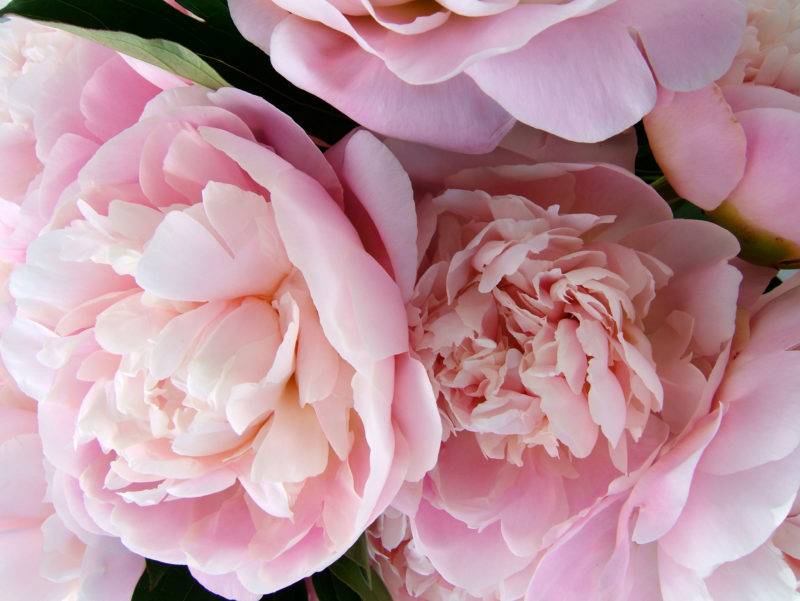
Foliage (trifoliate or pinnate) is arranged alternately on the stems. Flowers have different shades and colors. Single inflorescences sometimes reach a diameter of 25 cm. The ripe fruit has the shape of a star-shaped multileaf. The seed is round, longitudinal.
Peonies are appreciated by many gardeners and flower growers for their appearance and variety of colors. At the bush, each of the shoots ends with a flower, although there are subspecies where up to 7 buds can grow on one shoot. Moreover, the lateral ones bloom only after the central one.
Peony bushes can change the color of the foliage up to three times per season. In the spring they turn red, in the summer - malachite, in the fall - yellow-green or crimson.
Growing
Plant herbaceous peonies in central Russia from mid-August to mid-September. In spring, purchased imported material of tree and herbaceous peonies is planted in the ground. All peonies prefer fertile, well-drained, but not acidic soils and a place in the sun.
Plant young herbaceous specimens so that the replacement buds at the base of the shoots are at a depth of about 3-5 cm.
Provide the flowering shrub with supports. Remove wilted flowers immediately. Cut off herbaceous perennials as soon as their leaves die off in the fall.
Early, medium, medium late, late varieties
Peonies are conventionally divided into several flowering varieties.
Very early
They begin to bloom from about the first days of June. They bloom not very long, but profusely.
Aritina Nozen Glory


Semi-spreading bush with luxurious foliage. Plant height - 70 cm. The shade of flowers is violet-pink, short amber stamens, gathered in the form of a pompom in the very center of the inflorescence. Shoots are strong, drooping and straight. The leaf is large, light malachite, cut.
America
An equally delightful flower bush up to 0.75 m high. The color of the buds is pomegranate. The petals of the inflorescences are corrugated, wide at the edges, straight 0, smooth. The stamens are short, neatly gathered in the central part of the bud.


Several flowers are placed on each shoot, more precisely, about 4 flowers on each stem. Decorative leaf, green color. The smell is weak, this variety is considered universal, is popular with gardeners and florists.
Pearl placer
Tall (up to 85cm), slightly spreading bush. The bud is Japanese type, lilac, not very large.Staminodes (stamens) are slightly modified, in comparison with the previous variety, slightly reddish at the tips.
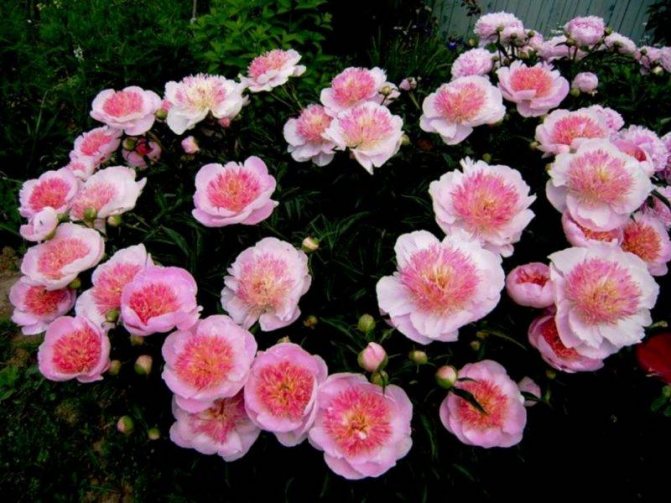

Straight shoots, small leaf, juicy green color. It develops and grows quickly, the seedlings take root well on any type of soil.
Duchess
Representative of the very first varieties. Peony of this variety is not very tall, branched. The flowers are large, snow-white with a green tint in the center of the ovary. The smell is gentle, persistent, reminiscent of the aroma of lily of the valley.
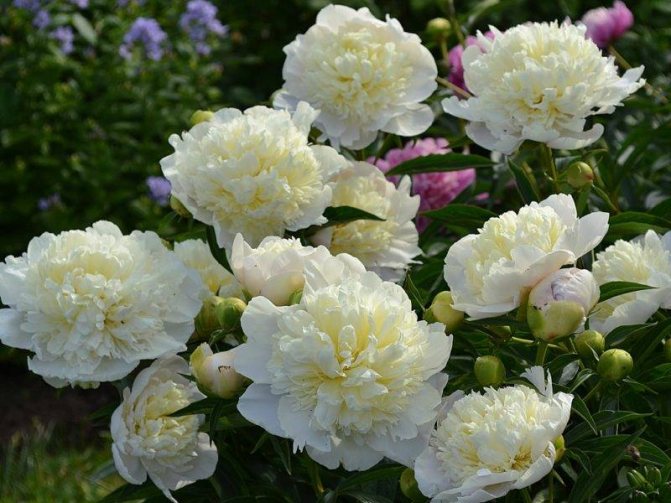

The stems are strong, straight, the leaf is large, cut-off. The plant takes root well on any soil, is resistant to the first frost, goes well with other types of flowers, and looks beautiful in a single planting option.
Peony varieties of medium flowering time
Mid-early peonies bloom after June 10, medium ones - starting from the 15th.
Sable
The bush grows almost a meter in height, branched. The flowers are dark crimson in color, the diameter of the inflorescence reaches 17 cm. The petal of the bud is wide, roundish in shape.
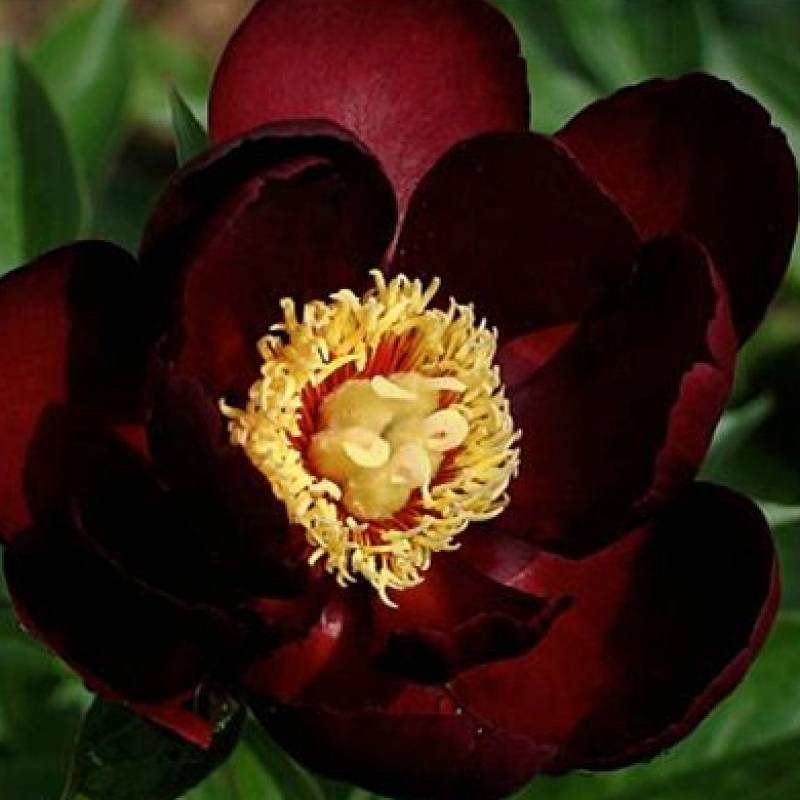

The ovary stamens are of medium length, bright yellow in color, tightly gathered in the center of the inflorescence. Stems are thin, long, elastic. The leaves are large, juicy, alternately placed on the stem.
Kurile Islands
A spreading beautiful meter high bush. Inflorescences of the Japanese type are lilac, large (Ø 18cm) and medium.


The stamens are concentrated in the center of the ovary in the form of a tuft. The stem is strong, the leaf is green, slightly shiny. The aroma is unobtrusive, very pleasant.
August Dessert
A bushy plant of medium height, with purple double and non-double flowers of medium to large sizes. Branching stems with bright juicy foliage. Ovary (Ø15 cm), hemispherical, juicy pink color. The petals of the bud are framed along the edge with a silvery border, which gives the flower attractiveness, charm and beauty.
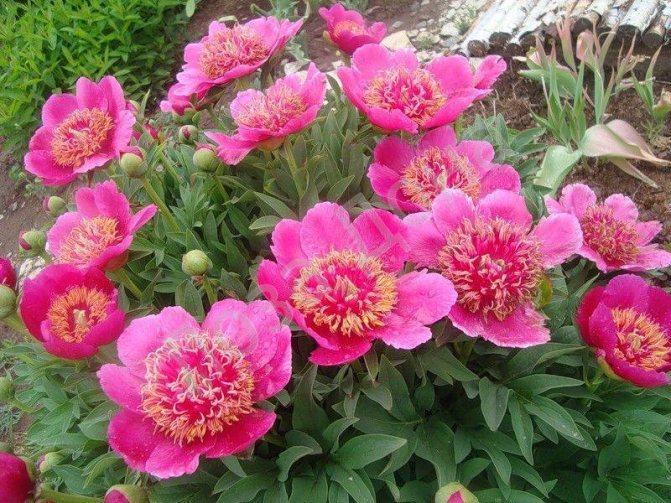

The inner petals are slightly smaller than the outer ones, the stamens are bright, bright yellow. The smell is unobtrusive, light and pleasant. It takes root in any soil, goes well with other flowers, looks unique in a single planting.
Bartzella
A semi-shrub hybrid that grows up to a meter in height. The flowers are velvety, bright yellow, Ø25 cm. The central part of the bud is decorated with red strokes.


Dark malachite leaf. Has a pleasant lemon scent. It is appreciated not only among domestic gardeners, it is often used in flower bed decoration by foreign flower growers.
Description of peonies of late flowering varieties
Medium late species bloom later on June 25, late - even later - on the 30th of the month.
Arkady Gaidar


A multi-stemmed, meter-long, semi-spreading plant. The flowers are hemispherical, double, bright purple, large (about 17 cm in diameter). The foliage is dense green, large, with reddish veins. Strong-smelling variety with a very pleasant aroma.
Anshantress
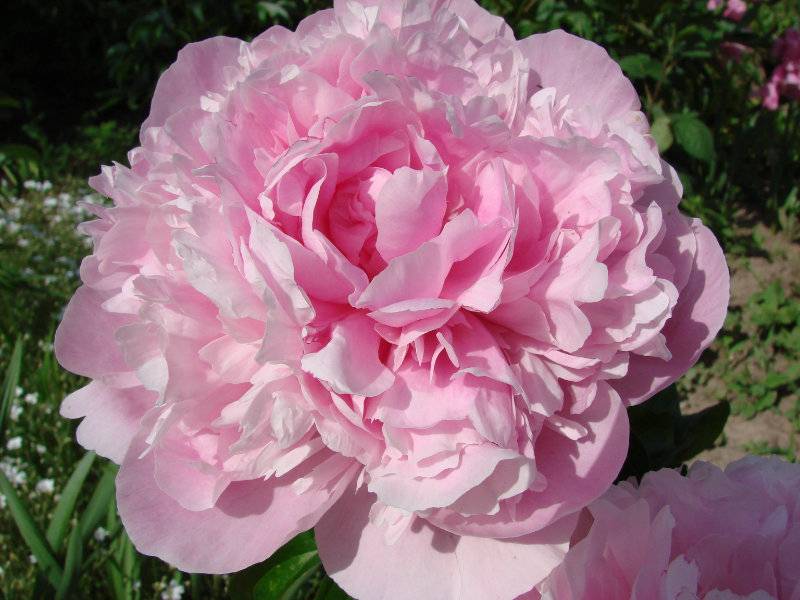

Terry peony, growing up to a meter in height. The shape of the bud is hemispherical, the color in the initial phase of flowering is pale yellow, during the period of intensive blooming it becomes purely snow-white (Ø18 cm). The scent resembles the scent of a rose. The stem is collecting, reddish in the upper part. The leaves are green, medium-sized.
George Peyton
Small-stemmed, spreading bush, 90 cm tall. The bud is terry, hemispherical, Ø 19 cm. The color is milky cream with a pink center, carved petals, wide. The stem is strong, the leaf is large, dark green.
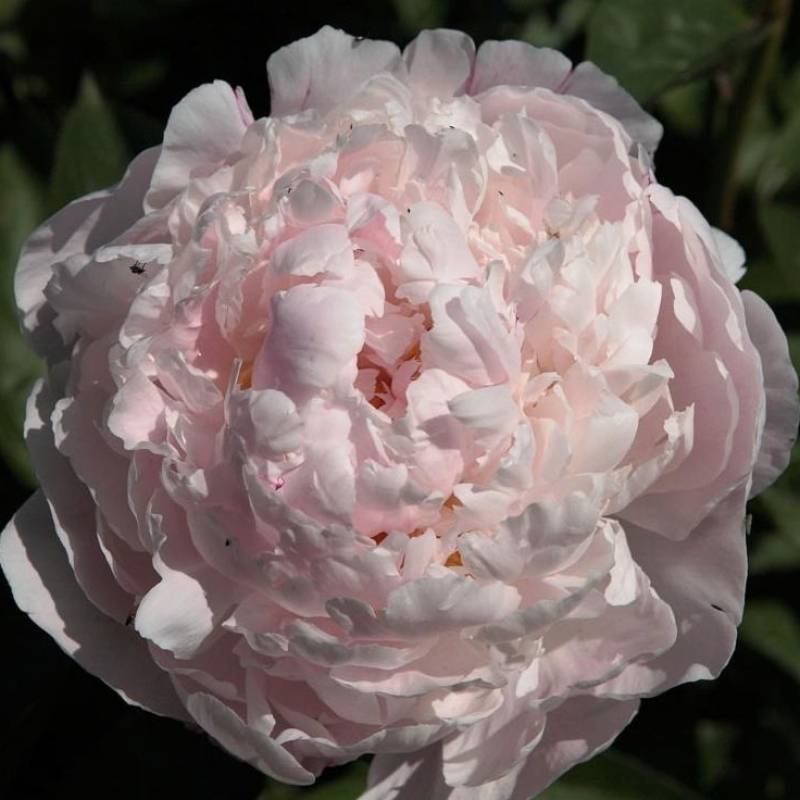

When growing peonies at home on the site, you need to apply fertilizers correctly and in a timely manner. It is not recommended to use grass or fresh manure. Mulch only with old compost. You can also not overfeed the bushes.
Beautiful flower
Peonies occupy one of the leading places among decorative perennial crops. Probably, it will not be an exaggeration to say that such flowers are found in almost every household plot.They are very popular with experienced and novice gardeners. Beautiful flowers are not only a decoration for any personal plot, but are also used for cutting. Fragrant bouquets look great in vases.
What are peonies? The culture refers to herbaceous perennials and deciduous shrubs (when it comes to tree peonies). Plants belong to the only genus of the peony family. The culture got its Latin name in honor of the legendary doctor Peanu, who healed people and gods from wounds received in battles.


China is considered the birthplace of culture. Varietal plants first came to Europe in the seventeenth century. Subsequently, they began to be called Chinese. At the beginning of the eighteenth century, garden peonies were brought from China to Japan, where new varieties with the Chinese type of flowers were bred. In France in the nineteenth century, through the efforts of breeders, new varieties of culture were obtained, which to this day remain true masterpieces of world selection.
According to the International Register, more than 4664 herbaceous varieties and more than 500 tree varieties are now registered.
Tree varieties
Tall deciduous shrubs in which the shoots are very strong (woody). Their height reaches 1.5 meters, in the south of the country they grow up to 2.5 meters. On the same meta, they can grow up to 150 years, which is why they are called long-livers.
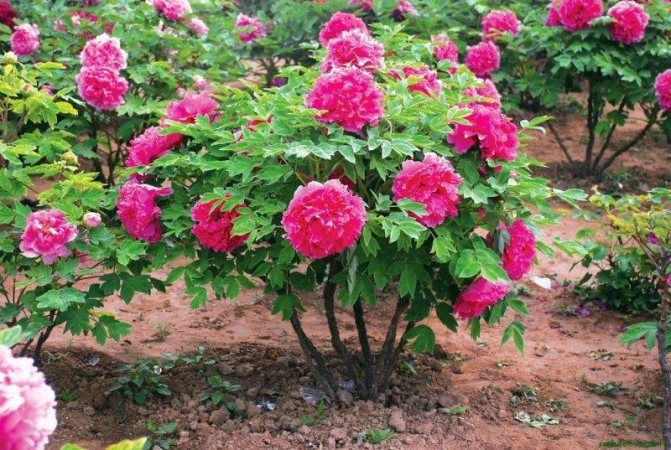

It blooms profusely, up to 70 buds can bloom on one shrub. The diameter of the flowers is impressive - up to 30 cm. The shape of the bud is in the form of a ball or a bowl. Bloom for 2 weeks. Bloom in late spring.
The color of flowers can be very different, depending on the type and selection. Treelike varieties of peonies are widely used in folk medicine, since they have blood-thinning properties, reduce high blood pressure, and tone the body.
Reproduction
Sow seeds of species peonies in autumn in boxes of sand in the greenhouse. After about 40 days, transfer them to an unheated greenhouse, and after a couple of weeks, move them back to the greenhouse. You can sow in open ground in the same autumn when the seeds ripen. Seedlings appear in May next year, and sometimes in two years.
Propagate varieties of herbaceous peonies by dividing the bush at the end of summer - cut the underground part of the plant with a sharp knife so that each division has at least three buds and thick roots. Treelike peony varieties are propagated by grafting, which is usually carried out by specialists.
Terry varieties
They have been popular in comparison with Japanese varieties for a long time. The shape of the bud is spherical.
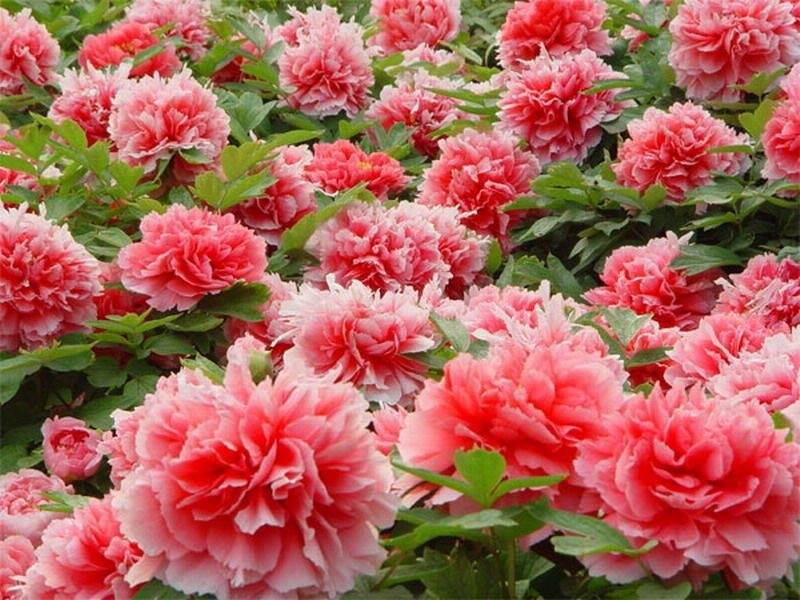

There are many petals in the flower, arranged in several tiers. The bush blooms profusely, it looks beautiful. The color of the flower in the first lower tiers is identical, the middle is slightly different, this gives more volume and beauty to the bud.
Plant history
What are peonies? These are the oldest plants. Even the ancient Egyptians and Babylonians laid beautiful gardens in which they tried to grow the most outlandish cultures brought from other countries. The Greeks and Persians set up gardens for educational purposes. The first mention of peonies dates back to those times.
Peony is a beautiful flower. Since ancient times, he has decorated the canvases of artists and palace halls. No wonder he was considered the king of all colors. In terms of splendor and beauty, peonies even competed with roses. The culture was revered and loved not only in China, but also in Europe. Legends were even made about beautiful flowers, attributing wonderful properties to them. In Greece, for example, a description of beads made from pieces of peony has been preserved. Such an ornament was worn from infancy. It was believed that beads scare away evil spirits and heal from ailments.
Even 1500 years ago in China, flowers adorned the beautiful imperial gardens. Already in those days, skilled court gardeners bred new varieties of peonies.An interesting fact is that ordinary people were strictly forbidden to grow such a culture. It was believed that the flower is very expensive and symbolizes wealth and nobility. Therefore, ordinary people were not supposed to have it in the garden.
It is worth noting that the meaning of the flower has not changed to this day. The peony still remains a symbol of nobility and wealth. To give a flower means to wish a person well-being and kindness.
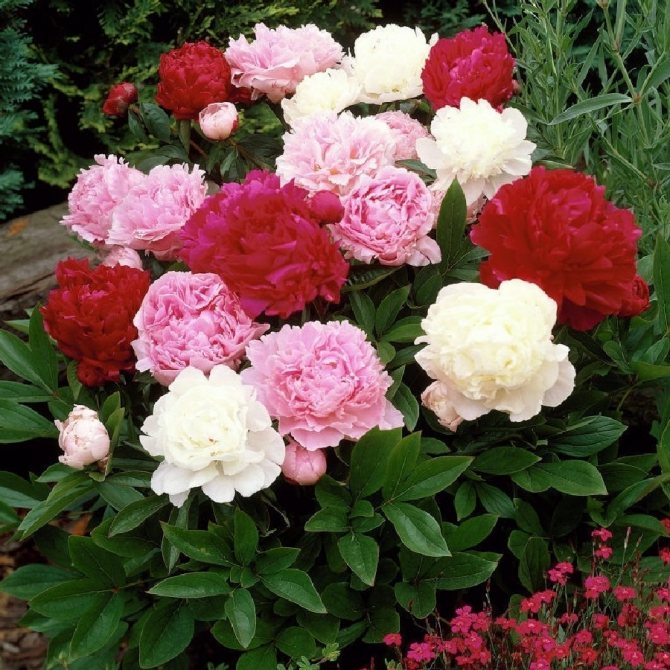

Japanese gardeners have managed to develop a large number of tree varieties. At the same time, the flower shape was obtained, which is now called Japanese.
Until now, many peoples attach great importance to peony flowers. For example, in the East, they are believed to kindle passion. Young girls need to keep flowers in their bedrooms to attract love. In ancient Rome, culture was considered a medicine. Therefore, the treatises described ailments in which the peony can be used as a remedy. Almost all famous healers of the ancient world used the plant for the preparation of medicinal potions. And nowadays in pharmacies you can buy a tincture of peony roots, which has a sedative effect. It is successfully used for sleep disorders.
The ancient Greeks considered the flower to be a symbol of longevity. In the ancient chronicles of the sixteenth century, there are references to the fact that peonies grew in the gardens of palaces and in monasteries. Presumably it is believed that the culture was brought to Russia by Peter I. But peonies came to Siberia and the Far East from Japan.
In Europe, culture is most loved in France. Famous gardeners of that time actively worked to create new varieties that are popular to this day.
In the late nineteenth century, American and English breeders also began to work on the development of new species. Thanks to their efforts, new flower colors have appeared in the world, and the decorativeness of plants has been increased.
Herbaceous
Luxuriously flowering perennials with a persistent aroma. They look very attractive, which is why they are used as decoration in the landscape.
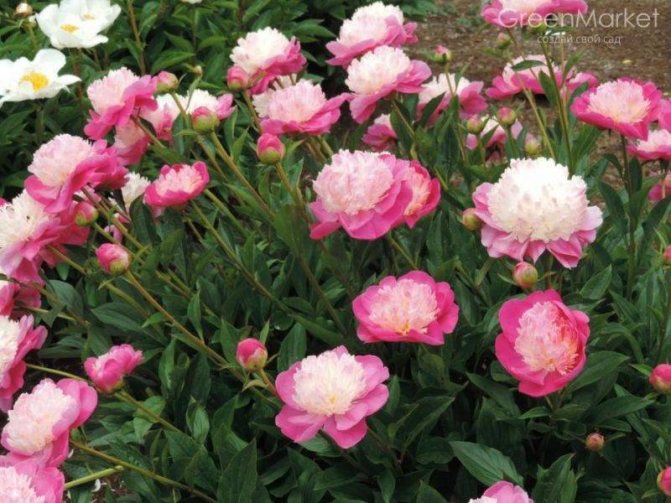

The height of the bush reaches 1.5 meters. The diameter of the flowers is different, depending on the variety, the color is also different. It is popular with gardeners due to its simplicity, ease of care, longevity and frost resistance.
dachniki.
Thank you, Alla! The link is interesting! The article is small, but efficient. The author writes about work in May: “At the beginning of the month, you can continue landing, transfer and division
rhizome perennials: phlox,
peonies (late flowering)
, daylilies, delphiniums, astilbe, chrysanthemums, host, nivyanikov ... "(emphasis mine)In early May, indeed, you can plant peonies, which were stored all winter in agro-industrial conditions, then around February they began to go to stores for sale. We buy them, maintain them in apartment conditions as best we can, we are terribly worried about them, then we plant them on our site and for a long time after that we continue to shaman over them with fright!
Peonies can even be divided in the spring, provided that there is a lot of experience in communicating with peonies. Because you need to accurately calculate the time for digging a bush. And this is given with a lot of experience, because every spring the weather conditions are different, so the digging time will be different. Unlike late summer and early autumn, when we have almost two months to divide the peonies, in the spring there are only 7-10 days that must be met, literally shot. Sometimes it's early April, sometimes mid-April, sometimes late April - early May. As soon as the ground thaws a little, the growth of the suction roots begins - you need to have time BEFORE.
The author of the article specifies - only for late flowering periods. Indeed, late-flowering milky peonies emerge a little later than early and medium-flowering milky peonies, not to mention hybrids that show red noses, sometimes from a thawed patch in the snow.But this is what is visible on the surface, and the growth of the white suction roots is in full swing and does not depend on whether the sprout has appeared from the ground or not.
About "like on peonies", probably talking about sweet juice. Ants love him, which is why there are so many of them on the buds. They do no harm to peonies. They just eat something sweet.
Igor, what pictures do you dislike? Tell me! I will fix it! Or do you not like the varieties, but my pictures are normal?
In this article, we want to talk about peonies gorgeous and beautiful colors for your garden. We will touch upon and analyze the most the best and most beautiful varieties of this plant and species.
Pion - one of the most beautiful and popular colors. The native land of the peony is North America, but because of its beauty, this flower spread very quickly throughout the world. In total, there are 34 species and more than 5000 varieties.
Peony classifications
The first criterion, by which peonies are divided - this is the origin and shape of the bush.
Tree peonies are divided into three types:
- Japanese - unpretentious to growing conditions. The petal-shaped stamens can be red, pink and yellow. The petals are the same color as the stamens and are arranged in one or two rows.
- Sino-European - large double buds are located on tall and strong stems. The bush itself is very sweaty. The flowers are pink or purple in color.
- Hybrids - the result of crossing a herbaceous and tree-like peony. Hybrid peonies combine the best qualities: fast growth, abundant flowering, bright and varied color of flowers, the ability to withstand very low temperatures.
Herbaceous peonies include all remaining species. It is worth saying that most of the peonies that are grown in summer cottages are herbaceous as well as hybrid ones.
Second criterion – this is the doubleness of the flower and its shape.
- Terry Is the most popular peony. It is he who can most often be found on the sites of amateur gardeners. The flowers of such a peony are large. The first three rows are large monochromatic petals, the entire remaining central surface is occupied by narrow petals, which give volume to the flower. As for the stamens, there are many of them, depending on their variety, they can be clearly visible, or maybe not, since they will be hidden among the petals.
- Semi-double peonies. Such peonies look very airy, their flowers are lush and large. The petals are arranged in 5-7 rows. The stamens can be located, like other flowers, in the middle of the bud, but can also form among the petals closer to the edge.
- Non-double have a non-double flower, the petals of which are located in 1-2 rows. One bud can contain up to 10-15 petals, depending on the variety.
- Anemone peonies differ in that their flower is very large in diameter. The first two rows are occupied by large petals, the central part is occupied by stamens and thin and short petals.
- Japanese peonies have large flowers that are located on very strong stems. The petals in the bud are arranged in a maximum of three rows, the rest of the space is occupied by petal-like large stamens. The stamens form large voluminous balls, which create all the charm.
Third criterion – this is the flowering period... In total, the peony has 7 flowering periods:
- Very early - flowering occurs in May or early June;
- Early - from June 6 to June 10;
- Mid-early - from 11 to 15 June;
- Average - from June 16 to June 20;
- Mid-late - from 20 to 25 June;
- Late - from 25 to 30 June;
- Very late - after the thirtieth of June.
This variety of flowering times allows gardeners to create a flower bed of peonies that would bloom from early May to early July without interruption.
Peony varieties
Each peony, regardless of species and variety, is beautiful. However, for many, many years, gardeners and botanists have identified the best varieties of peony. There are a lot of such varieties, so every grower will find a suitable one for himself.
Peony variety "Sarah Bernhardt"
This is a hybrid peony named after a French actress. Peony varieties Sarah Bernhardt has large (20 centimeters in diameter) semi-double flowers of pink color. Also, the flowers have a very strong scent of "expensive French perfume", which literally envelops the entire area.
The bush reaches a height of one meter, is very fluffy and strong, does not need support.
However, this variety has a peculiarity - peony Sarah Bernhardt shows varietal characteristics only in the second year of flowering.
Peony variety "Doris Cooper"
Flowers of this variety are double, very lush. The flower reaches 17 centimeters in diameter. Doris Cooper begins to bloom in early June, at which time the garden is filled with an excellent aroma with hints of jasmine.
Peony variety "Red Charm"
Hybrid variety with very large feathers. The buds attract attention not only for their doubleness, but also for their beautiful scarlet color. Thanks to this combination, the variety Red Charm looks very impressive.
The buds are firmly attached to the stems, as the stems are very strong. The bush reaches eighty centimeters in height, but because of the strength of the stems, no supports are required. However, an experienced gardener still recommend building a small support that will protect the bush from damage during strong winds.
Another value of the variety Red Charm is its ability to develop well and bloom excellently on absolutely any soil. The peony of this variety does not require frequent feeding: only once every three years is enough for it. Also, this variety is very resistant to severe frosts, so it does not require shelter for the winter.
Peony variety "Festival Maxim"
This variety is specially for white lovers. The flowers are huge (up to twenty centimeters in diameter), semi-double, have a snow-white color, but the tips of the petals in the center of the bud are reddish - this betrays a special beauty. In addition, they have a wonderful, pronounced aroma.
The bush is quite large, reaching a height of 120 centimeters. It is also very dense, and this density is formed by shoots, and 3-4 flowers bloom on each of these shoots. This description helps to present all the beauty varieties "Festival of Maxim" during flowering.
The peony of this variety lives from 6 to 8 years. Throughout its life, it blooms profusely, and even in the last years of its life, the number of buds does not decrease.
However, the variety has the same peculiarity as "Sarah Bernhardt" - it shows varietal characteristics only in the second year of flowering. Also, if your goal is to get large flowers (20 centimeters), then only one bud should be left on each shoot.
Peony variety "Anshantress"
Another variety that has white flowers, but unlike the previous one, flowers in “Anshantress " are white with a lemon tint (as soon as they bloom), and then they become pure white. Large (diameter - 2019 centimeters), double flowers have a mesmerizing scent that resembles the scent of a rose.
The bush reaches 100 centimeters in height. The stems are strong, capable of withstanding the considerable weight of blossoming flowers. Another reason for pride is the dark green foliage, covered with a kind of film that makes the foliage shine.
Peony variety "Bartzella"
A hybrid variety bred in 1986. The flower reaches 25 centimeters in diameter, double. It has a color that is not quite traditional for peonies - "Bartzella" blooms with bright yellow flowers, on the petals of which there are peculiar red strokes. Not only is the flower not only yellow, it also has a lemon scent.
Grows up to 90 centimeters in height. The leaves are juicy, dark green in color.
By planting such a peony in your area, you will destroy stereotypes about the color of flowers.
Peony variety "Mirage"
This variety belongs to the Japanese flowering type.The flowers are 13 centimeters in diameter, with large elliptical petals arranged in two or three rows. The real decoration is the modified stamens, which have the same light crimson color as the petals, but the edges of the stamens were "showered with gold."
The bush grows up to 110 centimeters, does not require support, since strong stems are able to independently withstand all heavy flowers, even during strong winds.
Variety "Mirage" known as an excellent park variety.
Peony variety "Duchess De Nemours"
This variety is very ancient, as it was one of the first to be grown in culture. The buds are white, but greenish-yellow in the middle, reaching nineteen centimeters in diameter.
The bush is very sprawling, up to 100 centimeters high. The stems are tall and straight. The leaves are quite large.
Peony variety "Barbara"
This peony variety blooms with large, lush, bright crimson flowers. The flowers reach 15 centimeters in diameter and exude a pleasant delicate aroma.
The bush is small, grows up to 70 centimeters in height. The foliage is a pleasant green color.
Peony variety "Etched Salmon"
It has earned the love of Russian and American gardeners due to its delicate peach flowers with a pink tint. The flower is terry, all the petals are tightly folded, when viewed from a distance, the flower will look like a rose.
Despite the tenderness that is observed in it, the variety Etched Salmon withstands very low temperatures, it also has a high immunity to diseases that most often affect peonies.
Peony variety "Pearl placer"
Blooms with buds of the Japanese type. The flowers are lilac-pink, up to 14 centimeters in diameter. The most beautiful flower is given by modified stamens with a pink tip.
The advantage of the variety is its rapid growth. Already in the second (and sometimes, in the third) year, the peony will delight you with abundant flowering.
This concludes the selection of varieties of peonies. Of course, we cannot show in one article all the abundance of varieties of this amazingly beautiful flower. If you still do not have a peony, then be sure to plant it, and it does not matter whether it is in our selection or not, because even the simplest peony brings some special beauty to the site.
Other varieties
The above list does not exhaust the list of plants of the Peony family common in domestic gardening. Florists enjoy no less love:
- Makinak Grand,
- Monsieur Jules Elie,
- Shirley Temple.
Particular attention was paid to the Ito-hybrids, which are perennials with annually dying off aerial parts, which allows the bushes to survive the winter period safely. Flowering begins in June. First, the buds located at the top of the bush bloom, and then the lateral ones begin to bloom. Due to this, the flowering period of Ito hybrids is slightly longer than that of ordinary plants of this family, and can reach 3 weeks.
More information about the varieties of ito peonies with photos and descriptions is in a separate article.
To read
The most popular are the hybrids obtained from crossing the yellow peony with other species, although other options are no less beautiful. ITO hybrids are attracted by the fact that their petals are quite variegated in color, when rich crimson can turn into flesh pink, and burgundy - into lemon yellow.


Border Charm
Outcome
Most of the varieties of peonies are varieties bred on the basis of the milky-flowered peony. All other representatives of the world of peonies are interspecific hybrids.
A huge contribution to the emergence of new varieties of peonies was made by the scientific work of the Botanical Garden of Moscow State University named after Lomonosov, namely its curator of the collection of tree-like Marianna Uspenskaya. Many honored gardeners recognized and appreciated the peonies and varieties bred and described by her. The catalog of plants approved for use in production in the Russian Federation contains many names of her favorite flowers - peonies, derived by her.
Pest control
To grow a healthy plant, you need to carry out prevention and pest control on time. Otherwise, the plants can be significantly damaged. What pests can threaten peonies and methods of dealing with them:
- Ants. Spray the bush and the ground around with repellents.
- Aphids are a small insect a few millimeters in size. A small number of aphids can be collected by hand or knocked down with a strong pressure of water. With a large amount, it should be treated with Fitoverm.
- Gall nematodes. Remove and burn the plant urgently to prevent pests from breeding. Disinfect the soil.
- Bronzovka. You need to collect the beetle by hand every day. Loosen the ground around the bush.
- Thrips. Spray with 0.2% solution of Karbofos. The procedure is carried out several times per season.
The decision to grow a beautiful garden plant like a peony is easy. Proper cultivation, attention and care, treatment is necessary. Only in this case will the peonies bloom with lush and bright flowers.
Selection of seedlings
When selecting material for planting, examine its root system, it is divided into open and closed. If, when purchased from a gardening store, the rhizome is bare or located in a bag of soil, then this is the first type. If a flower is provided in a container, and it has several buds - the second.
Examine this representative of the flora and for the presence of vaccinations. If present, the roots are dark and thick. Their diameter is about 4-5 cm. Such shrubs have flowers the next year after planting.
The seedling from the cut has a light thin rhizome. In this situation, the appearance of buds is expected no earlier than four years later.
Preparing the landing site
It is very important to choose the right place to plant your peonies. The site should be well lit and at the same time, it should be well protected from drafts and winds. When choosing a site for planting, it is worth remembering that peonies are large flowers that have been growing in one place for many years. To plant one bush, you need to set up a plot measuring 80 by 80 centimeters.
If the soil in the garden is acidic, it is necessary to add lime and clay to it. For further normal growth of the culture, regular application of wood ash will be required. Phosphogypsum must be added to the saline soil.
Ito-peonies
The new generation of culture is Ito-peonies. The varieties of hybrids appeared as a result of the irrepressible desire of breeders to obtain herbaceous forms with beautiful yellow flowers. In the process of breeding Ito hybrids, tree-like and milky-flowered species were used. The pioneer in the development of new forms was the Japanese Toichi Ito. In honor of him, the new hybrid was named. The breeder began painstaking work on the creation of a new plant back in 1948. Many years have passed since then, but his students continue his work, creating more and more new and improved species.
As a result of the most complex work, a separate branch of the culture was created, which is significantly different from the rest of the family.
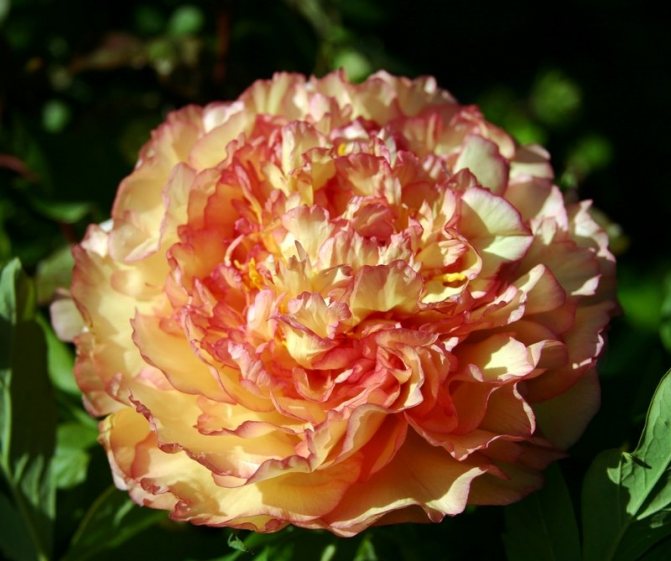

Ito hybrids are perennial plants with dying off ground shoots. The bushes reach a height of 50-90 centimeters. The leaves of the culture resemble the stems of treelike peonies.
Lemon Dream, White Emperor, Barcella, Border Charm, Viking Full Moon are the most famous Ito hybrids. Peony varieties differ in color and size of buds.
General information
They are second only to roses in beauty, and caring for them is simple and unpretentious. Even an inexperienced person in floriculture can handle it.
The main points in growing peonies are quite simple: every year it is advisable to feed them twice. Once - with organic fertilizers (at the beginning or at the end of the season), the second - with complex mineral fertilizers during or before flowering.
At the end of autumn, the dead stems of peonies are cut off, and the plant is sheltered for the winter. Often, the shelter is made with compost or peat mixture, which are organic fertilizers.


Peonies are some of the favorite garden plants.
In addition, these perennials in the bulk perfectly tolerate the winter conditions of our climate, often without any shelter and additional measures. Reproduction of peonies also does not present any particular problems.
A large number of hybrids of these plants with the most diverse forms of both bushes and flowers that have appeared at the present time can satisfy the tastes of any grower.
back to menu ↑
Read also: Periwinkle: description of the main species, recommendations for care and reproduction, medicinal properties (50+ Photos & Videos) + Reviews
Treatment of diseases
Reproduction of peonies
Almost all types of peonies are disease resistant. The exceptions are early flowering double hybrids. They are often susceptible to disease, but if action is taken, any plant can be cured.
Peonies usually attack a variety of fungi. Sometimes viral diseases can kill the plant. Great importance should be attached to the signs of the disease in order to make treatment on time:
- Rust. It is urgent to cut off the affected leaves and stems. Treat the bush with a 1% solution of Bordeaux liquid.
- Gray rot. Cut off diseased areas. Spray with 1% Bordeaux liquid solution.
- Powdery mildew. Treat the bush with a 0.2% Figon solution.
- Mosaic of leaves. Cannot be cured. The plant must be destroyed.
- Lemoine's disease. Does not respond to treatment.
- Verticillary wilting. Can't be cured. The shrub should be dug up, destroyed and the soil treated with bleach.
- Leaf spot. Does not respond to treatment.
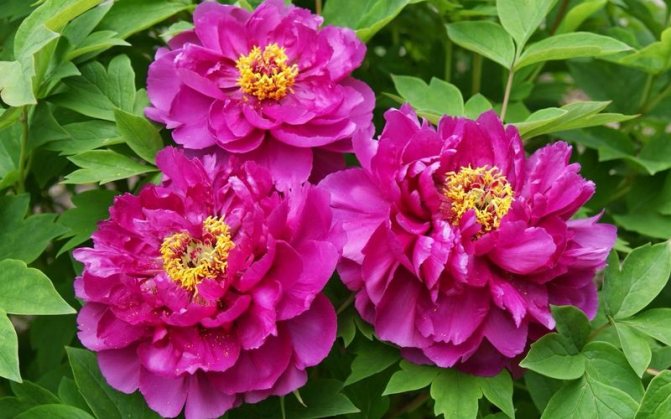

Early flowering double hybrids
Top dressing
To obtain abundant and long-term flowering, the bushes must be fed regularly. Plants that are more than two years old can be fertilized with ammonium nitrate. For this, the granules are scattered over the melted snow. To speed up the melting process, ash can be scattered.
Delenes planted in autumn can be fed after 10-15 days with a weak solution of ammonium nitrate. To do this, the granules (5-10 grams) are dissolved in a bucket of water (10 l).
Experienced growers believe that overfeeding peonies is very dangerous, as it can lead to poor flowering. A large amount of fertilizer makes the plant defenseless against infections.
In the process of caring for peonies, it is necessary to alternate foliar and root feeding. To do this, it is necessary to use humate, foundationol and preparations with a high content of trace elements.
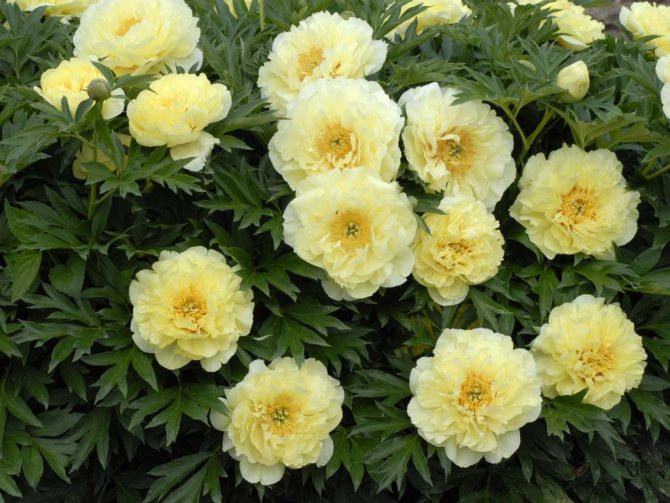

In addition, the plants can be fed with mullein. Cow dung is poured with water and infused for several days. Then the plants are watered with a settled solution. During the period of bud formation, it is recommended to add superphosphate to the mullein.
At the end of the flowering period, you can add a solution of wood ash, which is infused for four days (300 g of ash are taken for 10 liters of water).
Bouquets of peonies in different design styles 2019-2020 - photos, news, examples
If you want to surprise someone with a pleasant, non-binding surprise, order or create a bouquet of peonies with your own hands. Can't go wrong ... Here are some inspiration!
